Environmental Friendly Roofing: Sustainable Solutions

When it comes to roofing, choosing environmentally friendly options is crucial. Not only do eco-friendly roofs help reduce carbon footprint, but they also offer long-term benefits for both the environment and your wallet. By opting for sustainable roofing materials and practices, you can enjoy a durable roof that minimizes environmental impact while cutting down on energy costs. Whether it’s through solar panels, cool roofs, or recycled materials, eco-friendly roofing solutions provide a stark contrast to traditional options by promoting sustainability and energy efficiency. Make the switch to environmentally friendly roofing and make a positive impact on the planet while enhancing the value of your property.
Key Takeaways
- Opt for eco-friendly roofing options like green roofs or cool and energy-efficient roofs to reduce your environmental impact.
- Consider sustainable roofing materials such as recycled shingles or metal roofs for a more eco-conscious choice.
- Explore natural roofing options like wood shakes or clay tiles for a traditional and sustainable roof design.
- Incorporate high-tech solar solutions into your roofing plan to harness renewable energy and lower your utility bills.
- When choosing your eco-friendly roof, prioritize durability, energy efficiency, and sustainability to maximize long-term benefits.
- Regularly maintain your environmentally friendly roof to ensure its performance and longevity, including inspections for damage and cleaning to optimize energy efficiency.
Understanding Eco-Friendly Roofing
Sustainable Design
Eco-friendly roofing refers to environmentally conscious roof design and materials that minimize negative impacts on the environment. It is crucial in sustainable construction due to its ability to reduce energy consumption and promote environmental conservation.
Eco-friendly roofs are designed with sustainability in mind, utilizing materials that are recyclable and have a low carbon footprint. These roofs often incorporate features like solar panels, green vegetation, or reflective coatings to enhance energy efficiency.
Key Features
- Recyclable Materials: Eco-friendly roofs are made from recyclable materials such as metal, clay, or recycled shingles.
- Energy Efficiency: They are designed to reduce energy consumption by providing better insulation and ventilation.
- Longevity: Eco-friendly roofs have a longer lifespan than traditional roofs, reducing the need for frequent replacements.
- Water Management: These roofs often include features for rainwater harvesting or efficient water drainage systems.
Eco-friendly roofing options contribute significantly to reducing greenhouse gas emissions and decreasing energy consumption. By choosing sustainable roofing materials and designs, homeowners can lower their carbon footprint and support environmental conservation efforts.
Impact on Energy Efficiency
Eco-friendly roofs play a vital role in improving energy efficiency within buildings. By providing better insulation and ventilation, these roofs help regulate indoor temperatures, reducing the need for excessive heating or cooling. This results in lower energy bills for homeowners and a decreased reliance on non-renewable energy sources.
Moreover, certain eco-friendly roofing options, such as green roofs or solar panels, actively generate clean energy on-site, further reducing dependence on fossil fuels. The integration of renewable energy technologies into roofing systems not only benefits individual households but also contributes to overall energy sustainability at a community level.
Benefits of Green Roofs
Insulation Benefits
Green roofs provide excellent insulation, reducing the need for heating and cooling, leading to lower energy consumption. The soil and vegetation act as a natural insulator, keeping buildings cooler in summer and warmer in winter.
Air Quality Improvement
Plants on green roofs help filter pollutants and carbon dioxide from the air, improving overall air quality. They absorb harmful gases and release oxygen, creating a healthier environment for inhabitants.
Urban Heat Island Effect Reduction
Green roofs combat the urban heat island effect by absorbing and deflecting heat, reducing temperatures in urban areas. This helps lower energy usage for air conditioning during hot weather, contributing to a more sustainable urban environment.
Stormwater Runoff Reduction
By absorbing rainwater, green roofs help reduce stormwater runoff, alleviating pressure on drainage systems during heavy rainfall. This prevents flooding and erosion while also filtering pollutants from the water, benefiting the surrounding ecosystem.
Cost Savings
The installation of green roofs can lead to significant cost savings in the long run. They extend the lifespan of the roof membrane by protecting it from UV radiation and extreme temperatures, reducing maintenance costs over time.
Types of Sustainable Roofing
Cool Roofs
Cool roofs are made of materials that reflect sunlight and absorb less heat, reducing the need for air conditioning. This type of roofing helps lower energy costs and decrease urban heat island effects.
Cool Roofs:
- Reflect sunlight
- Lower energy costs
Wood Shingles
Wood shingles are eco-friendly and offer a natural aesthetic to buildings. They are durable, recyclable, and provide excellent insulation properties, making them a popular choice for sustainable roofing.
Wood Shingles:
- Eco-friendly
- Durable and recyclable
Metal Roofing
Metal roofing is long-lasting, recyclable, and requires minimal maintenance. It reflects solar radiant heat, reducing cooling costs during hot weather and is available in various styles to suit different architectural designs.
Metal Roofing:
- Long-lasting and recyclable
- Reflects solar radiant heat
Clay Tiles
Clay tiles are known for their durability, fire resistance, and ability to withstand harsh weather conditions. They provide natural insulation, reducing energy consumption and offering a traditional look to buildings.
Clay Tiles:
- Durable and fire-resistant
- Natural insulation properties
Slate Tiles
Slate tiles are highly durable, low-maintenance, and have a distinctive appearance. They are resistant to rot, mold, and insect damage, making them an environmentally friendly choice for sustainable roofing solutions.
Slate Tiles:
- Highly durable and low-maintenance
- Resistant to rot and mold
Solar Roofing
Solar roofing integrates solar panels into the roof’s design to generate electricity from sunlight. This sustainable roofing option reduces utility bills, decreases carbon footprint, and increases property value.
Solar Roofing:
- Generates electricity from sunlight.
- Reduces utility bills.
Factors to Consider When Choosing Sustainable Roofing
- Location: Consider the climate of the area where the building is located to choose a roofing material that can withstand local weather conditions.
- Energy Efficiency: Opt for materials that provide good insulation properties to reduce energy consumption for heating and cooling.
- Durability: Select roofing materials that are long-lasting to minimize maintenance needs and replacement costs.
Cool and Energy Efficient Roofs
Heat Reduction
Cool roofs are designed to reflect sunlight and absorb less heat, reducing the overall temperature in buildings. By utilizing cool roof options, these roofs minimize the amount of heat transferred to the interior spaces.
Installing cool roofs can significantly lower indoor temperatures during hot weather, enhancing indoor comfort without relying heavily on air conditioning systems. The use of solar roofing materials also contributes to this cooling effect.
Energy Efficiency
One of the primary benefits of cool roofs is their ability to save energy by reducing the need for air conditioning. These energy-efficient roofs help decrease cooling costs, making them a cost-effective choice for homeowners and businesses alike.
Metal roofs and friendly roof designs are popular choices for cool roofing projects due to their durability and longevity. Their reflective properties play a crucial role in maintaining comfortable indoor temperatures while lowering energy consumption.
Installation and Maintenance
When considering cool roof installations, it’s essential to consult with professionals to ensure proper implementation. The process involves applying specialized coatings or materials that enhance the roof’s reflective capabilities.
Regular maintenance is key to preserving the efficiency of cool roofs over time. Inspections should be conducted periodically to address any issues such as dirt accumulation or damage that may affect the roof’s performance.
Natural Roofing Options
Wood Shingles
Wood shingles are a versatile roofing option that offers a rustic charm to any property. They are typically made from cedar, redwood, or pine and provide excellent insulation. The natural appearance of wood shingles enhances the overall aesthetic of a building.
Wood shingles are known for their durability, with a lifespan of around 30 years when properly maintained. They are also biodegradable, making them an environmentally friendly roofing material. However, wood shingles may require more maintenance compared to other materials due to their susceptibility to rot and mold.
Clay Tiles
Clay tiles have been used for centuries and are renowned for their longevity and resilience. These tiles come in various colors and styles, adding a timeless elegance to homes. Clay tiles are highly durable, with a lifespan of up to 100 years.
One of the significant advantages of clay tiles is their eco-friendly nature. They are made from natural materials and can be recycled at the end of their lifespan, reducing environmental impact. Despite being prone to breakage, clay tiles offer excellent protection against harsh weather conditions.
Slate Tiles
Slate tiles are a premium roofing option known for their sophisticated appearance and exceptional durability. They come in a range of colors, adding a touch of luxury to properties. Slate tiles are resistant to fire, mold, and insect damage, making them a popular choice for homeowners seeking long-lasting roofing solutions.
Slate tiles have an impressive lifespan of over 100 years, outlasting many other roofing materials. Their low maintenance requirements make them a cost-effective choice in the long run. Slate is a natural resource, making it a sustainable option for environmentally conscious individuals.
Advantages of Natural Roofing Materials
- Enhance aesthetic appeal.
- Provide excellent insulation.
- Offer long-term durability.
- Reduce environmental impact through biodegradability and recyclability.
High-Tech Solar Solutions
Solar Panels
Solar roofing presents an innovative approach to sustainable energy solutions for homes. By harnessing the power of the sun, solar panels integrated into roofing systems can generate electricity.
Solar panels consist of photovoltaic cells that convert sunlight into electricity. These cells absorb photons from sunlight, creating an electric field that generates direct current (DC) electricity.
Energy Generation
As sunlight hits the solar panels on the roof, the photovoltaic cells convert it into electricity. This electricity can then be used to power the home’s appliances, lighting, and other electrical devices.
The excess electricity generated by the solar panels can be stored in batteries for later use or fed back into the grid for credits through net metering programs.
Cost Savings and Environmental Benefits
One of the key advantages of solar roofing is the long-term cost savings it offers homeowners. While the initial investment may be higher than traditional roofing materials, the savings on electricity bills over time can offset this cost.
By reducing reliance on traditional energy sources, solar roofing helps decrease greenhouse gas emissions and combat climate change. It also reduces the demand for fossil fuels, contributing to a cleaner and more sustainable environment.
Market Trends
The market for solar roofing products has been steadily growing as more homeowners recognize the benefits of renewable energy. With advancements in technology and increased awareness of environmental issues, solar roofing is becoming a popular choice for eco-conscious consumers.
Manufacturers are constantly developing new products and improving existing ones to make solar roofing more efficient and affordable. This trend is expected to continue as the demand for sustainable building materials rises.
Choosing Your Eco-Friendly Roof
Cool Roofs
Cool roofs are designed to reflect sunlight and absorb less heat than traditional roofs. They can help reduce indoor temperatures, lower energy costs, and lessen the urban heat island effect.
When considering cool roofs, look for materials with high solar reflectance and thermal emittance. These roofs are typically made of light-colored materials like white coatings or tiles that reflect sunlight effectively.
Natural Materials
Opting for natural roofing materials such as wood shakes, clay tiles, or slate can enhance the aesthetic appeal of your home while being environmentally friendly. These materials are durable, recyclable, and provide excellent insulation properties.
Consider the environmental impact of harvesting and transporting natural materials. Ensure they are sustainably sourced to minimize negative effects on the environment.
Solar Solutions
Solar roofing solutions integrate solar panels into the roof structure to harness renewable energy from the sun. These systems can generate electricity for your home, reducing your reliance on traditional power sources.
Evaluate the orientation and shading of your roof to determine its solar potential. Choose a reputable installer to ensure proper installation and maximize energy production.
Pros and Cons
- Pros: Energy-efficient, cost-effective in the long run.
- Cons: Initial installation costs can be high.
Factors to Consider
- Cost: Compare initial expenses with long-term savings.
- Durability: Assess the lifespan of each roofing option.
- Energy Efficiency: Look for options that offer optimal energy savings.
When selecting an eco-friendly roof, consider factors like upfront costs, maintenance requirements, and energy efficiency. It is essential to choose a roofing option that aligns with your budget, climate conditions, and sustainability goals.
Installation and Maintenance Tips
Installation
Proper installation of environmentally friendly roofing materials is crucial for maximizing their benefits. Start by ensuring that the roof structure can support the added weight of eco-friendly options. For instance, homes with weak structural support may require reinforcement before installation.
When installing cool roofs, natural materials like wood or slate, or solar solutions, it’s essential to follow manufacturer guidelines meticulously. This includes using compatible adhesives, fasteners, and sealants to prevent any damage to the roof over time. Hiring experienced professionals can guarantee a seamless and durable installation process.
Maintenance
Regular maintenance is key to preserving the integrity and longevity of eco-friendly roofing systems. Homeowners can benefit from simple maintenance tasks like clearing debris, inspecting for damage, and cleaning gutters regularly. These activities help prevent issues that could compromise the roof’s performance.
For cool roofs, periodic recoating with reflective materials can enhance their energy efficiency and extend their lifespan. Similarly, natural roofing materials such as wood shakes or clay tiles may require occasional treatments to prevent mold growth or damage from moisture. Solar panels should undergo routine inspections to ensure optimal energy production.
Importance of Inspections
Scheduled inspections play a vital role in identifying potential problems early on and addressing them promptly. By conducting regular inspections, homeowners can detect leaks, cracks, or loose shingles before they escalate into more significant issues. Timely repairs not only extend the roof’s life but also save on costly repairs down the line.
Moreover, professional inspections can assess the overall condition of eco-friendly roofs, checking for signs of wear and tear or damage caused by weather elements. Addressing these issues promptly through repairs or replacements can significantly increase the roof’s durability and performance. Homeowners should consider annual inspections to maintain their roof’s efficiency.
Closing Thoughts
You’ve learned about the various eco-friendly roofing options available, each offering unique benefits like energy efficiency, sustainability, and durability. By choosing a green roof, you’re not only investing in your property but also contributing to a healthier environment. Consider the different types of sustainable roofing materials and technologies discussed to make an informed decision that aligns with your values and needs.
Now that you’re equipped with knowledge about eco-friendly roofing, take the next step by exploring which option suits your home best. Whether it’s a cool roof to reduce energy costs or a solar solution to harness renewable energy, your choice can make a difference. Make a conscious decision for a greener future starting from the top – your roof.





